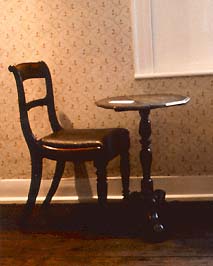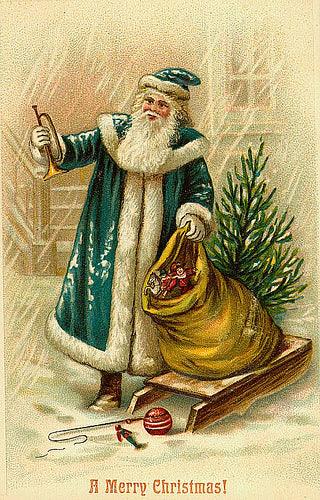The 17th Century Origins of the Candy Cane
 For some people, Christmas is all about the foods, for others, a single piece of candy cane or the scent of pine can bring them back to their childhood holidays. It is no stretch to suggest that the Candy Cane is one of the most Christmasized of all candies-- probably because it was created for the season and is fraught with meaning for those who choose to look for it.
According to legend, they have a German history, but given the German origins of the British monarchy during Jane Austen's life, it's not a stretch to think that the treat might have been brought over to England, along with the Christmas tree and other, older traditions, like the Yule Log. Did Jane enjoy stick candy or candy canes? We may never know.
"According to folklore, in 1670, in Cologne, Germany, the choirmaster at Cologne Cathedral, wishing to remedy the noise caused by children in his church during the Living Crèche tradition of Christmas Eve, asked a local candy maker for some sweet sticks for them. In order to justify the practice of giving candy to children during worship services, he asked the candy maker to add a crook to the top of each stick, which would help children remember the shepherds who paid visit to infant Jesus. In addition, he used the white colour of the converted sticks to teach children about the Christian belief in the sinless life of Jesus. From Germany, the candy canes spread to other parts of Europe, where they were handed out during plays reenacting the Nativity. As such, according to this legend, the candy cane became associated with Christmastide.
A recipe for straight peppermint candy sticks, white with coloured stripes, was published in 1844 in The Complete Confectioner, Pastry-cook, and Baker: Plain and Practical, by Eleanor Parkinson. The "candy cane" has been mentioned by name in literature since 1866.
Chicago confectioners the Bunte Brothers filed one of the earliest patents for candy cane making machines in the early 1920s. Meanwhile, in 1919 in Albany, Georgia, Bob McCormack began making candy canes for local children. By the middle of the century his company (originally the Famous Candy Company, then the Mills-McCormack Candy Company, and later Bobs Candies) had become one of the world's leading candy cane producers. But candy cane manufacturing initially required a fair bit of labor that limited production quantities. The canes had to be bent manually as they came off the assembly line in order to create their 'J' shape, and breakage often ran over 20 percent. It was McCormack's brother-in-law, a seminary student in Rome named Gregory Harding Keller, who used to spend his summers back home working in the candy factory. In 1957, as an ordained Roman Catholic Christian priest of the Diocese of Little Rock, Keller patented his invention, the Keller Machine which automated the process of twisting soft candy into spiral striping and then cutting them into precise lengths as candy canes.
For some people, Christmas is all about the foods, for others, a single piece of candy cane or the scent of pine can bring them back to their childhood holidays. It is no stretch to suggest that the Candy Cane is one of the most Christmasized of all candies-- probably because it was created for the season and is fraught with meaning for those who choose to look for it.
According to legend, they have a German history, but given the German origins of the British monarchy during Jane Austen's life, it's not a stretch to think that the treat might have been brought over to England, along with the Christmas tree and other, older traditions, like the Yule Log. Did Jane enjoy stick candy or candy canes? We may never know.
"According to folklore, in 1670, in Cologne, Germany, the choirmaster at Cologne Cathedral, wishing to remedy the noise caused by children in his church during the Living Crèche tradition of Christmas Eve, asked a local candy maker for some sweet sticks for them. In order to justify the practice of giving candy to children during worship services, he asked the candy maker to add a crook to the top of each stick, which would help children remember the shepherds who paid visit to infant Jesus. In addition, he used the white colour of the converted sticks to teach children about the Christian belief in the sinless life of Jesus. From Germany, the candy canes spread to other parts of Europe, where they were handed out during plays reenacting the Nativity. As such, according to this legend, the candy cane became associated with Christmastide.
A recipe for straight peppermint candy sticks, white with coloured stripes, was published in 1844 in The Complete Confectioner, Pastry-cook, and Baker: Plain and Practical, by Eleanor Parkinson. The "candy cane" has been mentioned by name in literature since 1866.
Chicago confectioners the Bunte Brothers filed one of the earliest patents for candy cane making machines in the early 1920s. Meanwhile, in 1919 in Albany, Georgia, Bob McCormack began making candy canes for local children. By the middle of the century his company (originally the Famous Candy Company, then the Mills-McCormack Candy Company, and later Bobs Candies) had become one of the world's leading candy cane producers. But candy cane manufacturing initially required a fair bit of labor that limited production quantities. The canes had to be bent manually as they came off the assembly line in order to create their 'J' shape, and breakage often ran over 20 percent. It was McCormack's brother-in-law, a seminary student in Rome named Gregory Harding Keller, who used to spend his summers back home working in the candy factory. In 1957, as an ordained Roman Catholic Christian priest of the Diocese of Little Rock, Keller patented his invention, the Keller Machine which automated the process of twisting soft candy into spiral striping and then cutting them into precise lengths as candy canes.
 In celebration of Saint Nicholas Day, December 6, candy canes are given to children as they are also said to represent the crosier of the Christian bishop, Saint Nicholas; crosiers themselves allude to the Good Shepherd, a title associated with Jesus."
In celebration of Saint Nicholas Day, December 6, candy canes are given to children as they are also said to represent the crosier of the Christian bishop, Saint Nicholas; crosiers themselves allude to the Good Shepherd, a title associated with Jesus."
Pulled Peppermint Candy Sticks (1844)Clove, Ginger, or Peppermint Candy.—These are all made in the same way as raspberry, using the essential oil of each for flavour. For clove, the mixture, whilst boiling, is coloured with cochineal; ginger with saffron; but the peppermint must be kept perfectly white, except the stripes, which is done by cutting off as many pieces from the bulk as you have colours, which should be in powder; put a sufficiency in each piece to give the desired tint, and keep them warm. When the remaining portion of the sugar is pulled, lay them over the surface in narrow stripes, double the roll together, and the face each way will be alike. Pull them out into long sticks, and twist them; make them round by rolling them under the hand, or they may be cut into small pieces with a pair of shears or scissors.
Raspberry Candy.—This may either be made from raw or refined sugar. Boil it to the crack, and colour it with cochineal; pour it on a stone rubbed over with a little oil or butter, cut off a small piece, and keep it warm to stripe or case the other part, when finished; to the remainder add a little tartaric acid (not so much as for drops), and some raspberry-paste, sufficient to flavour it. The residue of raspberries used for making vinegar, and preserved with an equal quantity of sugar, or even less, as for raspberry cakes, does very well for this purpose. Fold the edges over into the centre, and attach it to a hook fixed against the wall: pull it towards you, throwing it on the hook each time after having pulled it out; continue doing this until it gets rather white and shining, then make it into a compact long roll, and either stripe it with the piece you cut off, or roll it out in a sheet with a rolling-pin, and wrap it round it so as to form a sort of case; then pull it into long narrow sticks, and cut them the required length.
Historical information from Wikipedia.com, recipe from The Complete Confectioner, Pastry-cook, and Baker: Plain and Practical, by Eleanor Parkinson.


